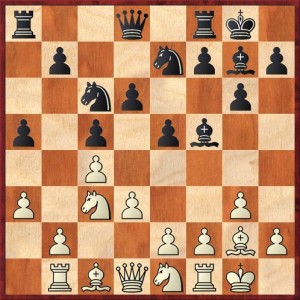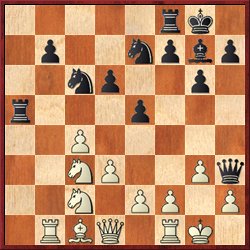Ordinarily a twelve-move draw isn’t something I write a blog post about, but this was kind of a surprise to me. I was playing Shredder again yesterday, which usually wins about twenty (or fifty?) games against me for every draw it gives up. We played a familiar opening, the Symmetrical Variation of the English:
Shredder — Dana
1. Nf3 c5 2. g3 Nc6 3. c4 e5 4. Nc3 g6 5. Bg2 Bg7 6. a3 Nge7 7. Rb1 a5 8. O-O d6 9. Ne1 …
The more popular move order is 9. d3. It seems to me as if Shredder’s move abandons the center a little bit more quickly than necessary, although it should end up transposing to the other line. I decided to play something I wasn’t familiar with, because the whole point of playing all these games against Shredder is to try new things.
9. … Bf5 10. d3 O-O
FEN: r1bq1rk1/1p2npbp/2np2p1/p1p1p3/2P5/P1N3P1/1P1PPPBP/1RBQNRK1 w – – 0 10
Black’s plan is to play … Qd7 and … Bh3 if allowed to do so, but it’s important to castle first in order to defuse Nc3-b5.
Now I would expect a human to play Nc2, both to support the b2-b4 break and also to free e1 for the rook. Instead, Shredder plays a couple of really clunky moves that don’t seem to have a lot to do with the position.
11. Bd2 Qd7 12. Qa4 …
And here, to my shock, Shredder offered a draw! I accepted, just so that I’d have something to write about here. Also I’m sure that if we had played on, I would have eventually messed up and lost. It’s what always happens.
So what happened? Why did the computer offer a draw? Well, looking at Shredder’s annotations gives a hint. First, the move 9. … Bf5 not only took me out of my book, it took Shredder out of its book, so it had to figure out what to do in the position. Second, it evaluated the position as dead even (0.00) for three consecutive moves, after 10. d3, 11. Bd2, and 12. Qa4. I’ve noticed before that Shredder will typically offer a draw in the endgame when it hits an evaluation of 0.00, although it doesn’t usually do it right away.
This game makes me think that there is actually a subroutine in Shredder that automatically offers a draw when the evaluation is 0.00 for three consecutive moves. If so, it’s definitely a flaw in the program… and another illustration of how hard it is to program computers to play human-like chess. Humans have a sense of when a position is “hopelessly drawn,” and it’s not a 0.00 evaluation on three consecutive moves. The position in this game was anything but hopelessly drawn — the game was just beginning!
Just out of curiosity, I put the game on Rybka. It gave White an edge of +0.23 after 10. d3 and 11. Bd2, which went down to +0.15 after the toothless move 12. Qa4.
Also I looked up on ChessBase to see if the position had ever occurred in human play. The answer was no — nobody has ever played Shredder’s 11. Bd2. However, there were some interesting games with 11. Nc2, including a cool game Hartoch-Velimirovic from 1994 that went 11. Nc2 Qd7 12. b4 cb!? 13. ab Bh3!? 14. Bxh3 Qxh3 15. ba Rxa5 (diagram).
FEN: 5rk1/1p2npbp/2np2p1/r3p3/2P5/2NP2Pq/2N1PP1P/1RBQ1RK1 w – – 0 16
Hartoch, probably in awe of his grandmaster opponent, decided it wouldn’t be prudent to take the pawn on b7, thus depriving us of some interesting fireworks. He played 16. Rb5 Rxb5 17. cb instead, and Velimirovic went on to win. If 16. Rxb7 Black could have played 16. … e4! threatening a lightning mating attack with … Ra5-h5 and … Qxh2 mate. It looks as if White’s only defense is 17. Nb5, and then 17. … Ne5! pours even more oil on the fire, offering a knight sacrifice that can’t be accepted because of … Ng4 and … Qxh2 mate. However, according to Rybka White can hold with 18. f3! (only move) ef 19. ef Nf5, and Black eventually sacrifices a knight on g3 and draws. I wonder how much of this Velimirovic saw?
That’s it for today. If anyone else has Shredder (perhaps a later version?) it would be interesting to find out if you can also get it to play this 12-move draw.





{ 3 comments… read them below or add one }
Fascinating. I would have hoped that Shredder, as a 3200 player, had better fighting spirit than this. Instead, she sets a bad example for youth and GMs alike.
In the manner of Asimov’s Laws of Robotics, perhaps computer software should be programmed with Danailov’s Sofia Rules.
Your story reminds me of when Fidelity used to offer a bounty for the quickest wins against its Challenger computers.
Fritz was always the exact opposite, playing on even when the game was ridiculously drawn. I think I had draws against it that went close to 200 moves. It would insist on playing out the 50-move rule, and sometimes it would go 49 moves and then play an inferior pawn move (even a pawn sac) just to avoid the draw. There has to be a happy medium between Fritz and Shredder’s draw algorithms.
You can be sure that if I ever beat Shredder, I’ll post the game here!
On my old iBook I could actually beat Shredder.
Once I had played a deep (and winning) exchange and pawn sacrifice in our club championship. Afterwards I let Shredder chew on the position over night, but it only found the first move, not the idea.
Nowadays Houdini finds it in less than a minute …